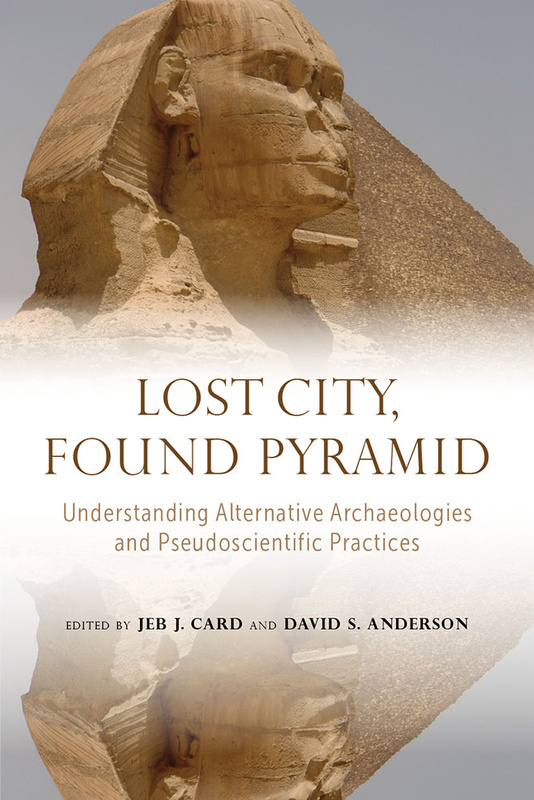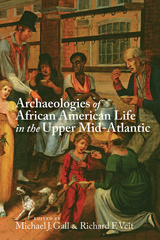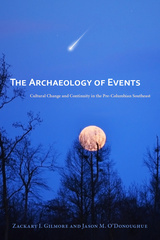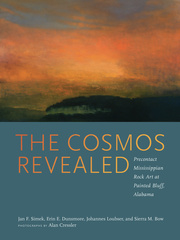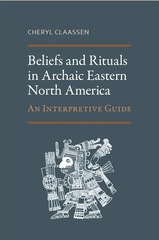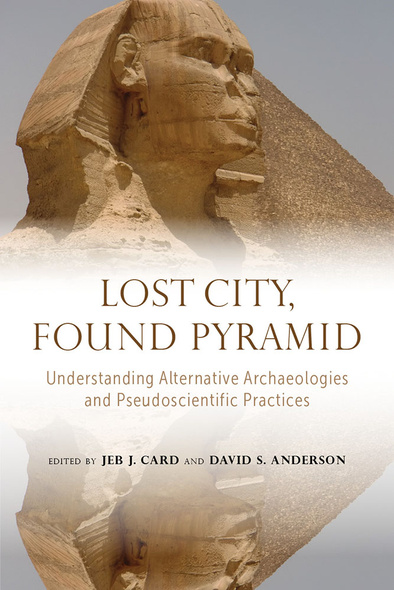
272 pages, 6 x 9
29 B&W illustrations, including 2 maps - 4 tab
Hardcover
Release Date:15 Sep 2016
ISBN:9780817319113
Lost City, Found Pyramid
Understanding Alternative Archaeologies and Pseudoscientific Practices
Edited by Jeb J. Card and David S. Anderson
University of Alabama Press
Highly recommended." —CHOICE
Lost City, Found Pyramid delves into the fascinating world of sensational “pseudoarchaeology,” from perennial discoveries of lost pyramids or civilizations to contemporary ghost-hunting and reality TV. It examines how nonscientific pursuit of myths and legends warps both public perceptions of archaeology and of human history itself.
A collection of twelve engaging and insightful essays, Lost City, Found Pyramid does far more than argue for the simple debunking of false archaeology. Rather, it brings into focus the value of understanding how and why pseudoarchaeology captures the public imagination. By comprehending pseudoarchaeology’s appeal as a media product, cultural practice, and communication strategy, archaeologists can enhance and enliven how they communicate about real archaeology in the classroom and in the public arena.
The first part of Lost City, Found Pyramid provides numerous case studies. Some examine the work of well-intentioned romantics who project onto actual archaeological data whimsical interpretative frameworks or quixotic “proofs” that confirm legends, such as that of the Lost White City of Honduras, or other alternative claims. Other case studies lay bare how false claims may inadvertently lead to the perpetuation of ethnic stereotypes, economic exploitation, political adventurism, and a misunderstanding of science.
Offering much of interest to scholars and students of archaeology, archaeology buffs, as well as policy-makers involved in the discovery, curation, and care of archaeological sites and relics, Lost City, Found Pyramid provides an invaluable corrective and hopeful strategy for engaging the public’s curiosity with the compelling world of archaeological discovery.
Lost City, Found Pyramid delves into the fascinating world of sensational “pseudoarchaeology,” from perennial discoveries of lost pyramids or civilizations to contemporary ghost-hunting and reality TV. It examines how nonscientific pursuit of myths and legends warps both public perceptions of archaeology and of human history itself.
A collection of twelve engaging and insightful essays, Lost City, Found Pyramid does far more than argue for the simple debunking of false archaeology. Rather, it brings into focus the value of understanding how and why pseudoarchaeology captures the public imagination. By comprehending pseudoarchaeology’s appeal as a media product, cultural practice, and communication strategy, archaeologists can enhance and enliven how they communicate about real archaeology in the classroom and in the public arena.
The first part of Lost City, Found Pyramid provides numerous case studies. Some examine the work of well-intentioned romantics who project onto actual archaeological data whimsical interpretative frameworks or quixotic “proofs” that confirm legends, such as that of the Lost White City of Honduras, or other alternative claims. Other case studies lay bare how false claims may inadvertently lead to the perpetuation of ethnic stereotypes, economic exploitation, political adventurism, and a misunderstanding of science.
Offering much of interest to scholars and students of archaeology, archaeology buffs, as well as policy-makers involved in the discovery, curation, and care of archaeological sites and relics, Lost City, Found Pyramid provides an invaluable corrective and hopeful strategy for engaging the public’s curiosity with the compelling world of archaeological discovery.
These case studies help readers understand the motivations and methods of alternative archaeologists. . . . They argue that scholars must respond to pseudoarchaeology and pseudoscience both reactively and proactively. Excellent bibliography. Summing Up: Highly recommended.' —CHOICE
'Lost City, Found Pyramid is a strong contribution that I hope will encourage more professionals to get off the bench and use their expertise, communication skills, and platforms to do some good.'
—American Antiquity
'This book is a genuine contribution to the field and should prove valuable to a broad cross section of both practicing archaeologists and advanced archaeology students.' —Troy Lovota, author of Inauthentic Archaeologies: Public Uses and Abuses of the Past and coauthor of Understanding Graffiti: From Prehistory to the Present
Jeb J. Card is a visiting assistant professor of anthropology at Miami University in Ohio. He is the editor of The Archaeology of Hybrid Material Culture.
David S. Anderson is a visiting assistant professor of anthropology at Roanoke College and the coeditor of Constructing Legacies of Mesoamerica: Archaeological Practices and the Politics of Heritage in and beyond Mexico.
David S. Anderson is a visiting assistant professor of anthropology at Roanoke College and the coeditor of Constructing Legacies of Mesoamerica: Archaeological Practices and the Politics of Heritage in and beyond Mexico.
List of Illustrations
Acknowledgments
Alternatives and Pseudosciences: A History of Archaeological Engagement with Extraordinary Claims by Jeb J. Card and David S. Anderson
Chapter 1. Steampunk Inquiry: A Comparative Vivisection of Discovery Pseudosciences by Jeb J. Card
Part I: Case Studies in Alternative Constructions of the Past: Methods, Ideologies, and Practitioners
Chapter 2. The Lost White City of the Honduras: Discovered Again (and Again) by Christopher Begley
Chapter 3. Witches, Shamans, and Looters: Alternative Uses and Contemporary Ritual Reuse of Archaeological Remains in the North-Central Coast of Peru by Stacy Dunn
Chapter 4. Black Olmecs and White Egyptians: A Parable for Professional Archaeological Responses to Pseudoarchaeology by David S. Anderson
Chapter 5. Creationist History-Making: Producing a Heterodox Past by James S. Bielo
Chapter 6. Creating Pyramids: Participation, Performance, and Pseudoarchaeology in Bosnia-Herzegovina by Tera C. Pruitt
Part II: How Archaeologists Should or Should Not Engage with Pseudoarchaeology
Chapter 7. The Central Australian Face: A Study of Archaeological Responses to a Pseudoarchaeological Claim by Denis Gojak
Chapter 8. The Proliferation of Pseudoarchaeology through "Reality" Television Programming by Evan A. Parker
Chapter 9. Lessons Learned from Lost Civilizations by Kenneth L. Feder, Terry Barnhart, Deborah A. Bolnick, and Bradley T. Lepper
Chapter 10. Ghost Hunting as Archaeology: Archaeology as Ghost Hunting by April M. Beisaw
Chapter 11. Answering Pseudoarchaeology by Kenneth L. Feder
Works Cited
Contributors
Index
Acknowledgments
Alternatives and Pseudosciences: A History of Archaeological Engagement with Extraordinary Claims by Jeb J. Card and David S. Anderson
Chapter 1. Steampunk Inquiry: A Comparative Vivisection of Discovery Pseudosciences by Jeb J. Card
Part I: Case Studies in Alternative Constructions of the Past: Methods, Ideologies, and Practitioners
Chapter 2. The Lost White City of the Honduras: Discovered Again (and Again) by Christopher Begley
Chapter 3. Witches, Shamans, and Looters: Alternative Uses and Contemporary Ritual Reuse of Archaeological Remains in the North-Central Coast of Peru by Stacy Dunn
Chapter 4. Black Olmecs and White Egyptians: A Parable for Professional Archaeological Responses to Pseudoarchaeology by David S. Anderson
Chapter 5. Creationist History-Making: Producing a Heterodox Past by James S. Bielo
Chapter 6. Creating Pyramids: Participation, Performance, and Pseudoarchaeology in Bosnia-Herzegovina by Tera C. Pruitt
Part II: How Archaeologists Should or Should Not Engage with Pseudoarchaeology
Chapter 7. The Central Australian Face: A Study of Archaeological Responses to a Pseudoarchaeological Claim by Denis Gojak
Chapter 8. The Proliferation of Pseudoarchaeology through "Reality" Television Programming by Evan A. Parker
Chapter 9. Lessons Learned from Lost Civilizations by Kenneth L. Feder, Terry Barnhart, Deborah A. Bolnick, and Bradley T. Lepper
Chapter 10. Ghost Hunting as Archaeology: Archaeology as Ghost Hunting by April M. Beisaw
Chapter 11. Answering Pseudoarchaeology by Kenneth L. Feder
Works Cited
Contributors
Index

